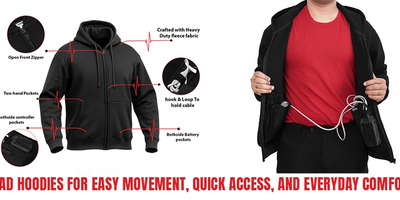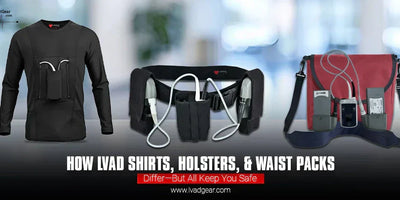
Can You Shower with an LVAD? Here is what you need to know
Ever think how something as simple as taking a shower can be a big task for you after an LVAD? Well, it doesn’t need to be stressful. Many patients like you are facing the same problem. Actually, it is one of the very common questions patients and their families ask after LVAD implantation: “Can I shower safely? What will happen if the device gets wet? Or how can I prevent device damage?
Living with an LVAD can be a challenge at the start, but here is some good news: you can still manage to find ways that will ease your burden. It is true that you will have to make an entirely new lifestyle, and showering is one of them. But it entirely depends on you how you appreciate your new life with an LVAD by taking care of yourself in the right way. Don’t worry, it is definitely possible for you to maintain your hygiene without compromising on the device’s safety.
We will help you understand so that you can shower safely and confidently with your LVAD.
How long after an LVAD can you take a shower?
LVAD surgery is one of the major heart surgeries, and you will fully recover in 3 to 6 months. Usually, every patient takes their own time because of the patient factors that can affect the recovery period. But when should you take a shower? Once your incision site has fully recovered, you can take a shower. But you still need to protect the controller, batteries, and driveline from getting wet.
Always consult with your doctor and take advice on how and when you can shower, while still taking care of the LVAD device. A study developed a tool known as LVAD Bathing Assessment to help identify risks and improve care. However, further studies may be needed for its accuracy.
How you maintain your hygiene when you can’t take a shower after an LVAD?
Not cleared by your healthcare team to shower yet? That means you are still recovering from LVAD surgery. In that case, you need to make simple adjustments to stay clean. Remember one thing always. No matter if you are just cleaning with simple techniques or taking a shower after LVAD, you must keep your device protected from water at all costs. Let’s say you still cannot take a shower or it’s just too early for you, then how do you do it? Here is what you can do:
Take sponge baths: Use a warm, damp wash cloth or sponge with mild soap to gently clean your body. Be sure to cover the driveline site completely to keep it dry and focus on cleaning areas like underarms, neck, and back. Don’t use a cloth with dripping water.
Wash hair separately in a basin: Try using a dry shampoo or ask a caregiver to help wash your hair over a basin.
Keep Dry Towels near you: Keep dry towels with you to clean the wet surface of the body immediately. Don’t let the water come near the driveline site to prevent infection.
Use Cleansers without using water: Use cleansers to maintain body hygiene without rinsing. It is mostly suitable for you if you have sensitive skin or if you just had an LVAD implant a few weeks ago.
How can you prepare yourself for showering after LVAD?
Now that your doctor has given you the green light, you will be able to take a proper shower, but with some proper techniques. There is no harm in preparing yourself for a task when it comes to the safety of the device. It may take more time than expected, but you will get used to it and will be able to shower with great ease.
Self-care plays a key role in helping LVAD patients adjust to life with the device and can lead to better health outcomes. While education on self-care is important, more research is needed to understand how to best support patients in managing their daily care routines.
Get Ready Before the Shower:
- Always prepare your body beforehand. Take plenty of rest and charge your body to use energy during a shower.
- Gather all the necessary equipment, which may include a Heartmate shower bag, waterproof medical tape, sterilized scissors, and plastic lining to cover the driveline site.
- Wash your hands properly before touching the driveline site, as it will reduce the chances of infection.
- Make sure your driveline and anchor are properly attached without kinking.
- Now, prepare a plastic liner and keep it on your abdominal area to have an idea of how much you're going to need it. It must cover the driveline site, the anchor, and the tail of wire.
- Mark the cutting points from each side of the plastic liner just below the anchor holding the driveline.
- Also, mark on either side of the driveline with the same plastic liner.
- Now that you have markings, remove the plastic liner from the patient and cut according to the markings on a clean surface. Don’t use scissors near the driveline or any sharp object.
- Now, you will have a rectangular and a tail portion of the plastic liner. Place the rectangular on the abdomen and the tail on the driveline.
- Tape the sides of the liner first and then the side opposite the driveline. Place firmly on the tape, so that there will be no chances of entering water through any gap.
- Wrap the tail of the plastic liner around the driveline and then tape this side firmly first on below the driveline and then on the top of the driveline. Don’t apply tape directly on the driveline.
- Add extra pieces of tape in an X shape.
Setting up the LVAD Shower Bag:
Place the batteries first in the shower bag, and place the controller in a designated slot with the screen facing upward, so that you can see through. Keep all the wires inside the bag and zip it. Make sure the driveline exits through a red slot. Top up the bag with a second layer and fasten the clip.
Note: Keep the batteries fully charged before entering the shower.
During the Shower:
Wear the shower bag with a strap on your shoulder. Keep the bag close to your driveline exit site so that there will be fewer chances of tugging the wire.
Note: Do not let someone hold the bag for you, and avoid pouring water directly on the shower bag.
Recheck after Shower:
- Dry the shower bag by using a towel and pat dry the whole body.
- Start removing the plastic liner from the tail, and then remove the tapes carefully from each side of the driveline site.
- Start removing the plastic liner from the top corner and roll down to avoid water droplets from entering the driveline site.
- Remove the batteries and the controller from the bag and place them in your LVAD gear, like an LVAD shirt or an LVAD vest.
- If you see wet batteries and a controller, then immediately contact your doctor.
- Change your dressings if the exit site is wet after the shower.
- If you hear an alarm during the shower, stop the procedure right there and call your doctor for assessment.
- Planning to change your dressing also? Take a shower first and then change the driveline site dressing. Also, learn from our guide on Learning how to do your own LVAD Dressing Changes.
Some Precautions for Taking a Shower with an LVAD:
It’s true that showering with an LVAD is not like before, but it is completely doable. Just prepare, protect, and follow your healthcare team’s guidelines so that you stay safe and clean without putting your device at risk. The precautionary measures you should take are described below:
- Avoid taking a bath in water tubs, as you cannot submerge yourself or the LVAD components in water.
- Make a fixed time for your shower 2 to 3 times a week, or how you feel convenient.
- Check the device and its functioning before and after the shower.
- Take a shower at that time of the day when you feel maximum energy.
- Use clean towels and sterilized equipment. Try to clean the area where you take a shower to prevent infection. A case was reported where a 54-year-old patient got an LVAD infection after his first shower at home due to contaminated items in his bathroom.
- Keep the area dry to avoid slipping.
- Avoid using powder near the driveline site.
Conclusion
Showering with an LVAD may seem exhausting to you at first, and it’s true that it can overwhelm you. But with a little practice and the right set of instructions, it will become just another part of your routine. Try to focus on one thing only – protect your driveline and external components.
Once you learn the technique effectively, you will feel more confident and in control. So take one step at a time, stay safe, and know that living well with an LVAD is absolutely possible.
FAQs
Is it possible to swim after having an LVAD?
No, you are not allowed to go swimming after an LVAD because the controller and the batteries cannot get wet for safety purposes.
How do you sleep with an LVAD?
You should sleep on your back or on your side, but never on your stomach. Try sleeping with the LVAD sleeping belt that keeps your device secure and protected while you rest.
What will happen if my battery dies?
If the LVAD battery dies, then the pump will stop working, which can be fatal. Always have backup batteries, and in case of emergency, contact your LVAD center.
What is an LVAD shower bag?
The LVAD shower bag keeps the external components of the LVAD away from getting wet during the shower. The bag is waterproof and specifically designed to maintain the hygiene of patients with LVAD.
Is it possible to travel with an LVAD?
Yes, it is possible to travel with an LVAD after complete recovery. However, you need to consult with your doctor before you travel by air or road.
What is a bridge to transplant?
Patients with heart failure often need an organ transplant but have to wait for a suitable donor. In such cases, your doctor will perform a temporary treatment like LVAD until you get a suitable donor heart. The LVAD treatment used here is known as a bridge to transplant.
Prev post

Exercise Precautions and Guidelines after LVAD
Updated on 04 August 2025
Next post

A Guide to Better Heart Health: Easy Diet and Lifestyle Fixes
Updated on 02 July 2025








